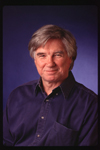非常抱歉,
你要访问的页面不存在,
非常抱歉,
你要访问的页面不存在,
非常抱歉,
你要访问的页面不存在,
验证码:

职称:Adjunct Professor
所属学校:University of California-Los Angeles
所属院系:Department of Life Sciences Core Education
所属专业:Biology/Biological Sciences, General
联系方式:(310) 825-1910
Two general questions are being studied in my lab. One is, how, and to what extent, does the nervous system control protein expression in skeletal muscle fibers? These studies have shown that although the nervous system has a significant influence on the kind and amount of specific proteins synthesized, there are factors intrinsic to individual fibers that also define these properties. The results show also that the neural influence that is associated with muscle fiber types is probably not mediated via the amount or pattern of activity of the motor units. Whole muscle, single motor units and single muscle fibers are studied physiologically and biochemically. Light and confocal microscopy including quantitative enzyme analyses and immunofluorescent microscopy are some of the experimental methods used to study motor unit plasticity. The principal animal models used are spinal cord injury, spaceflight and surgically induced compensatory hypertrophy. A second, and general question is how the neural networks in the lumbar spinal cord of mammals, including humans, control stepping and how this stepping pattern becomes modified by chronically imposing specific motor tasks on the limbs after complete spinal cord injury. Limb motion, electromyographic and kinetic data are recorded to define locomotor characteristics. These studies have shown that the mammalian spinal cord can learn specific complex motor tasks such as standing and stepping. Studies are conducted with humans with spinal cord injury as well as with laboratory animals. Approach: My lab has a very multidisciplinary and integrative approach to science. It involves techniques to assess the kinetics and kinematics of locomotion, the activation patterns of those motor pools that generate the movement and the segmental and sensory networks that modulate the output of these motor pools. In our experiments we also study cell and tissue properties (nerve and muscle) that are important in generating the behavioral characteristics observed. These analyses consist of enzyme activities of single muscle or neural cells, cell morphology, the kinds of proteins synthesized, the modulations of the mRNA's of specific myonuclei as well as the physiological properties of the nerve and muscle cells. In short, our studies are designed to define the cellular and subcellular features of tissues that form the basis for the properties of specific movements. We use a variety of experimental perturbations of the neuromuscular system in order to understand its adaptive potential and to define the physiological mechanisms that induce these adaptations. Significance: Our studies have a basic, as well as an applied aspect to them. There are many important, but unanswered questions about the plasticity of the neuromuscular system. Since the neural and the muscular systems are the primary systems that are responsible for the functional features of movement control, it is important to understand how they are defined and how they are modulated to become more or less dysfunctional.
Two general questions are being studied in my lab. One is, how, and to what extent, does the nervous system control protein expression in skeletal muscle fibers? These studies have shown that although the nervous system has a significant influence on the kind and amount of specific proteins synthesized, there are factors intrinsic to individual fibers that also define these properties. The results show also that the neural influence that is associated with muscle fiber types is probably not mediated via the amount or pattern of activity of the motor units. Whole muscle, single motor units and single muscle fibers are studied physiologically and biochemically. Light and confocal microscopy including quantitative enzyme analyses and immunofluorescent microscopy are some of the experimental methods used to study motor unit plasticity. The principal animal models used are spinal cord injury, spaceflight and surgically induced compensatory hypertrophy. A second, and general question is how the neural networks in the lumbar spinal cord of mammals, including humans, control stepping and how this stepping pattern becomes modified by chronically imposing specific motor tasks on the limbs after complete spinal cord injury. Limb motion, electromyographic and kinetic data are recorded to define locomotor characteristics. These studies have shown that the mammalian spinal cord can learn specific complex motor tasks such as standing and stepping. Studies are conducted with humans with spinal cord injury as well as with laboratory animals. Approach: My lab has a very multidisciplinary and integrative approach to science. It involves techniques to assess the kinetics and kinematics of locomotion, the activation patterns of those motor pools that generate the movement and the segmental and sensory networks that modulate the output of these motor pools. In our experiments we also study cell and tissue properties (nerve and muscle) that are important in generating the behavioral characteristics observed. These analyses consist of enzyme activities of single muscle or neural cells, cell morphology, the kinds of proteins synthesized, the modulations of the mRNA's of specific myonuclei as well as the physiological properties of the nerve and muscle cells. In short, our studies are designed to define the cellular and subcellular features of tissues that form the basis for the properties of specific movements. We use a variety of experimental perturbations of the neuromuscular system in order to understand its adaptive potential and to define the physiological mechanisms that induce these adaptations. Significance: Our studies have a basic, as well as an applied aspect to them. There are many important, but unanswered questions about the plasticity of the neuromuscular system. Since the neural and the muscular systems are the primary systems that are responsible for the functional features of movement control, it is important to understand how they are defined and how they are modulated to become more or less dysfunctional.